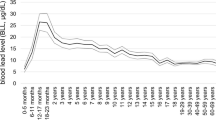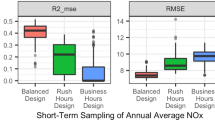Abstract
For the Phase I field test of the National Human Exposure Assessment Survey (NHEXAS) in U.S. Environmental Protection Agency (EPA) Region 5, this paper presents the survey sampling design, the response rates achieved, and the sample weighting procedure implemented to compensate for unit nonresponse. To enable statistically defensible inferences to the entire region, a sample of about 250 members of the household population in EPA Region 5 was selected using a stratified multistage probability-based survey sampling design. Sample selection proceeded in four nested stages: (1) sample counties; (2) area segments based on Census blocks within sample counties; (3) housing units (HUs) within sample segments; and (4) individual participants within sample households. Each fourth-stage sample member was asked to participate in 6 days of exposure monitoring. A subsample of participants was asked to participate in two rounds of longitudinal follow-up data collection. Approximately 70% of all sample households participated in household screening interviews in which rosters of household members were developed. Over 70% of the sample subjects selected from these households completed the Baseline Questionnaire regarding their demographic characteristics and potential for exposures. And, over 75% of these sample members went on to complete at least the core environmental monitoring, including personal exposures to volatile organic compounds (VOCs) and tap water concentrations of metals. The sample weighting procedures used the data collected in the screening interviews for all household members to fit logistic models for nonresponse in the later phases of the study. Moreover, the statistical analysis weights were poststratified to 1994 State population projections obtained from the Bureau of the Census to ensure consistency with other statistics for the Region.
This is a preview of subscription content, access via your institution
Access options
Subscribe to this journal
Receive 6 print issues and online access
$259.00 per year
only $43.17 per issue
Buy this article
- Purchase on Springer Link
- Instant access to full article PDF
Prices may be subject to local taxes which are calculated during checkout
Similar content being viewed by others
Author information
Authors and Affiliations
Corresponding author
Rights and permissions
About this article
Cite this article
WHITMORE, R., BYRON, M., CLAYTON, C. et al. Sampling design, response rates, and analysis weights for the National Human Exposure Assessment Survey (NHEXAS) in EPA Region 5. J Expo Sci Environ Epidemiol 9, 369–380 (1999). https://doi.org/10.1038/sj.jea.7500054
Published:
Issue Date:
DOI: https://doi.org/10.1038/sj.jea.7500054
Keywords
This article is cited by
-
Elderly hospitalization and the New-type Rural Cooperative Medical Scheme (NCMS) in China: multi-stage cross-sectional surveys of Jiangxi province
BMC Health Services Research (2016)
-
Exposure Modeling of Benzene Exploiting Passive–Active Sampling Data
Environmental Modeling & Assessment (2010)
-
Reconstructing population exposures to environmental chemicals from biomarkers: Challenges and opportunities
Journal of Exposure Science & Environmental Epidemiology (2009)
-
A participant-based approach to indoor/outdoor air monitoring in community health studies
Journal of Exposure Science & Environmental Epidemiology (2009)
-
Response to “μg/kg-day or μg/day? A commentary on Georgopoulos et al., JESEE 2008”
Journal of Exposure Science & Environmental Epidemiology (2008)



